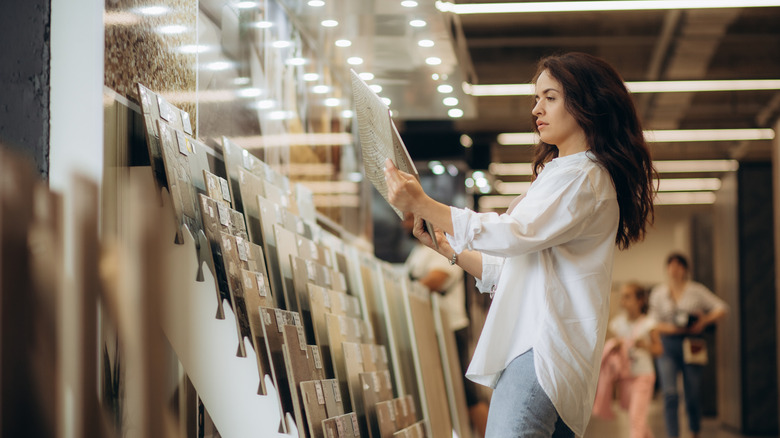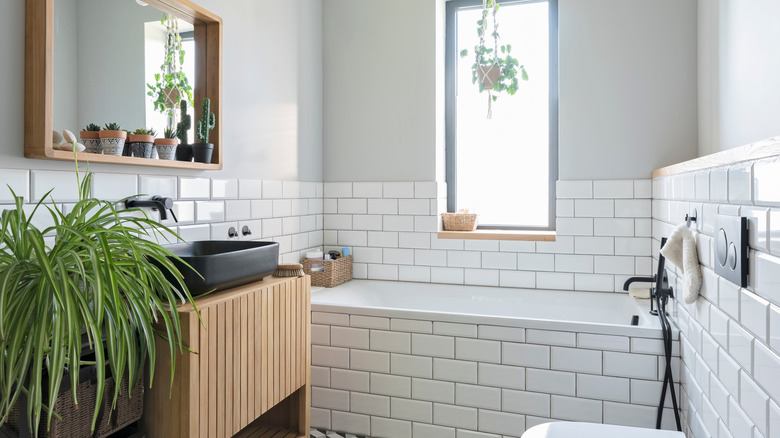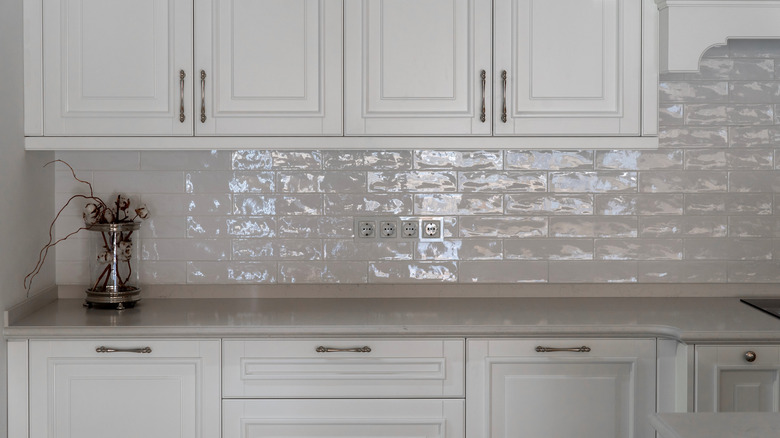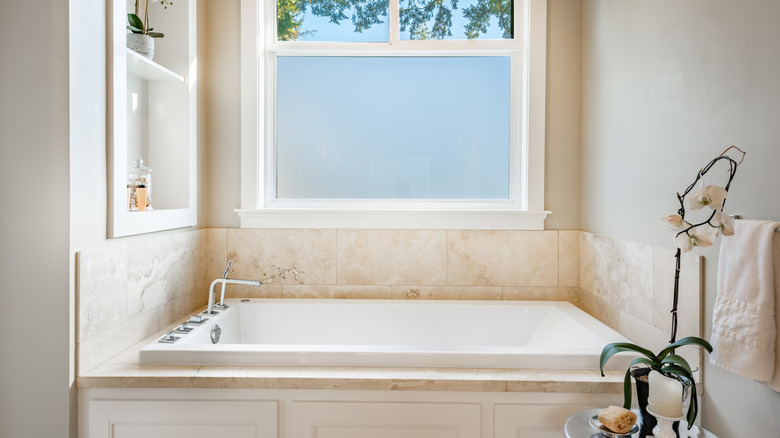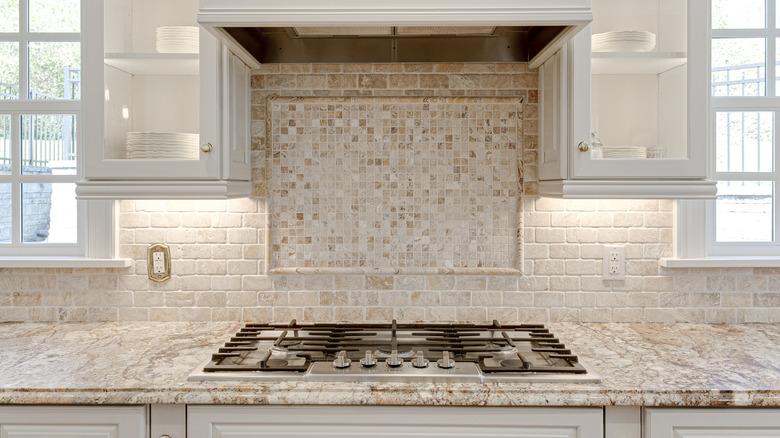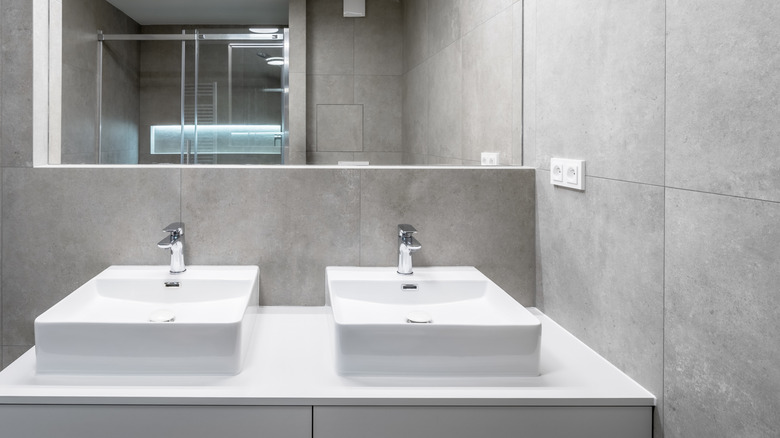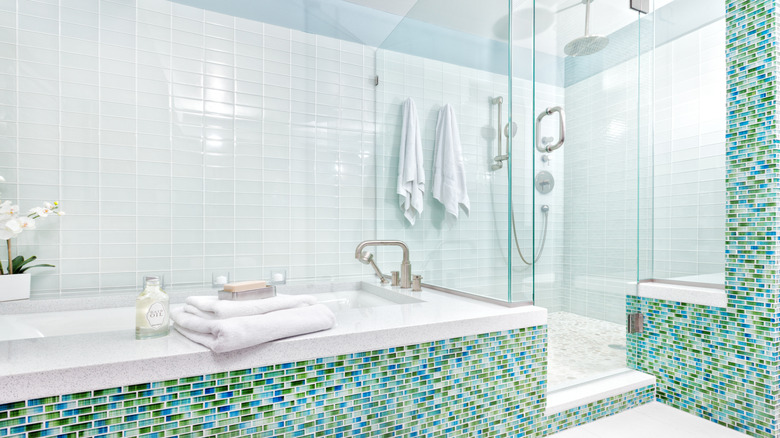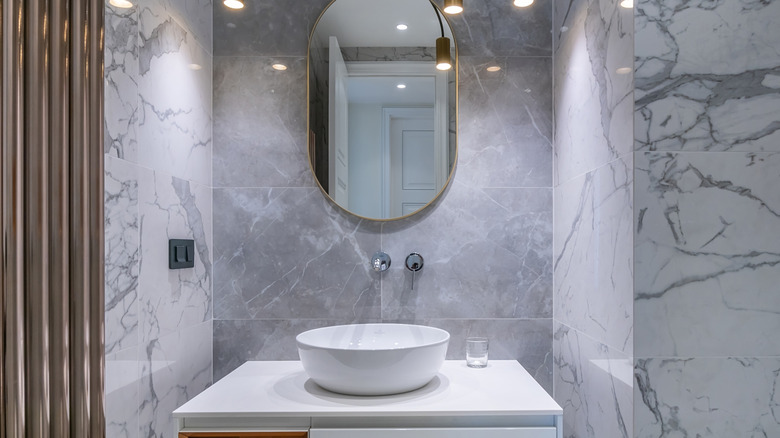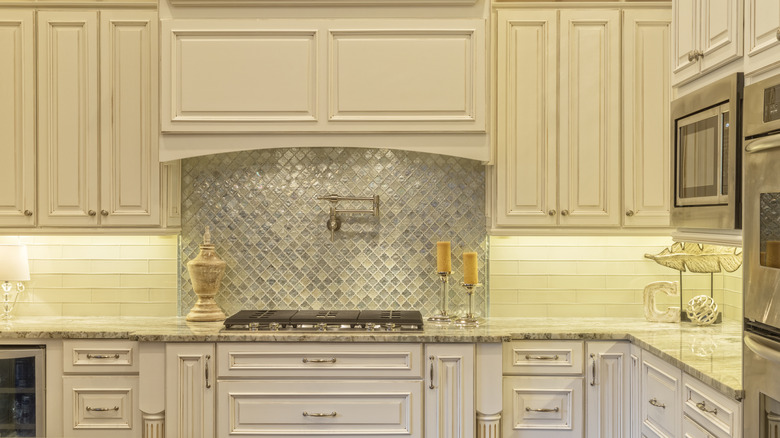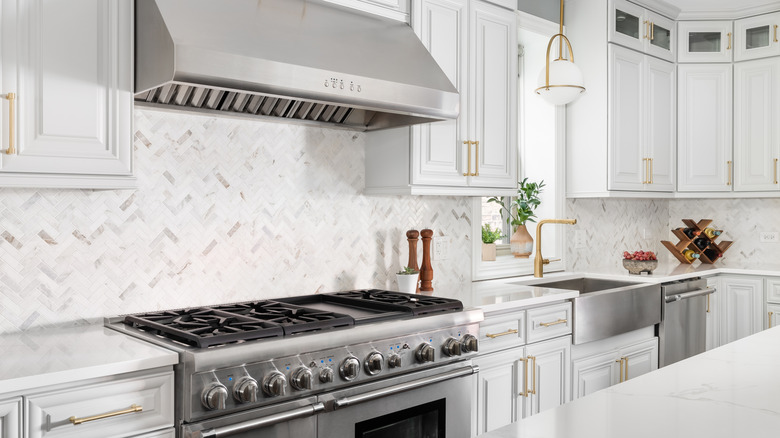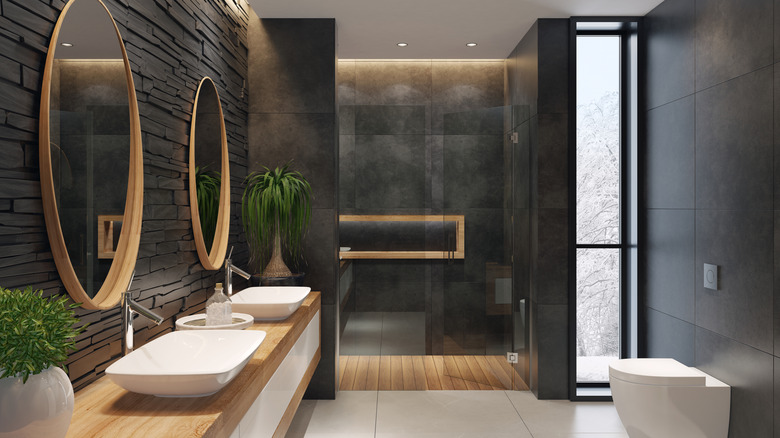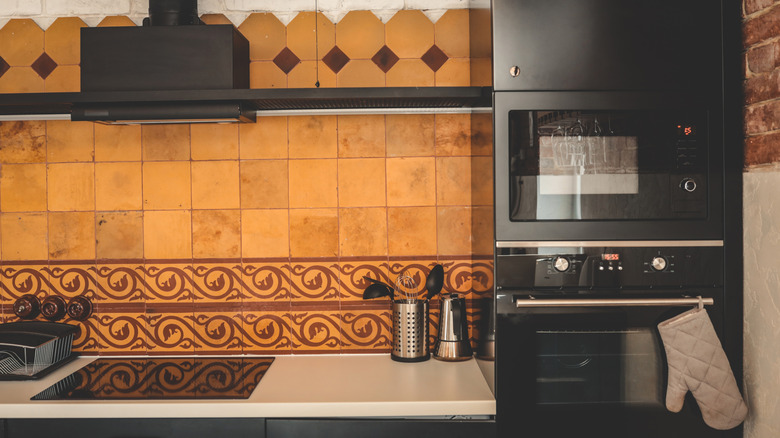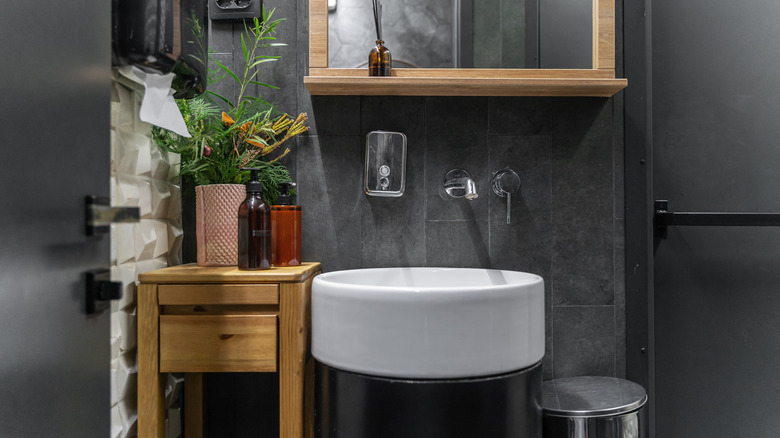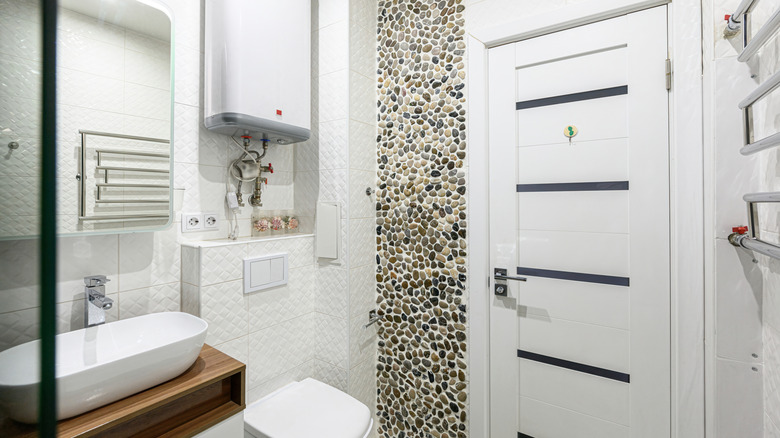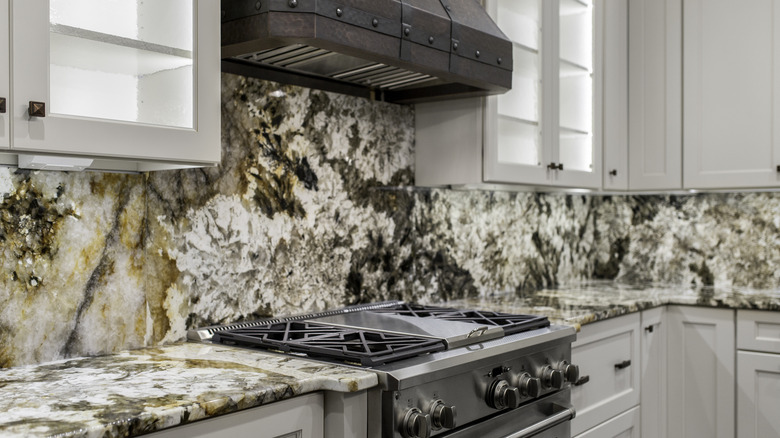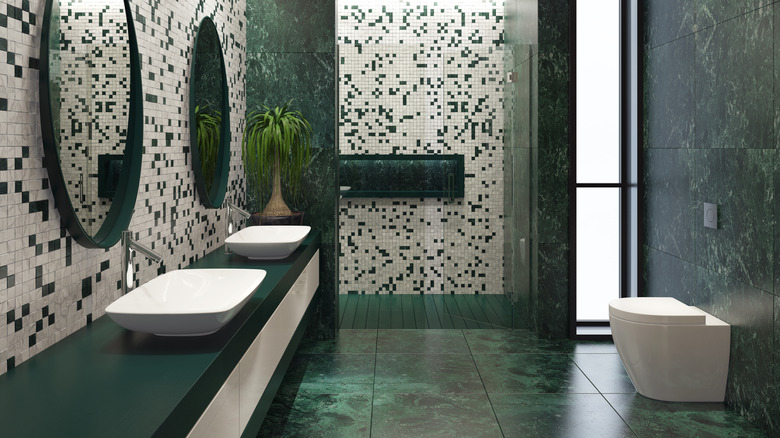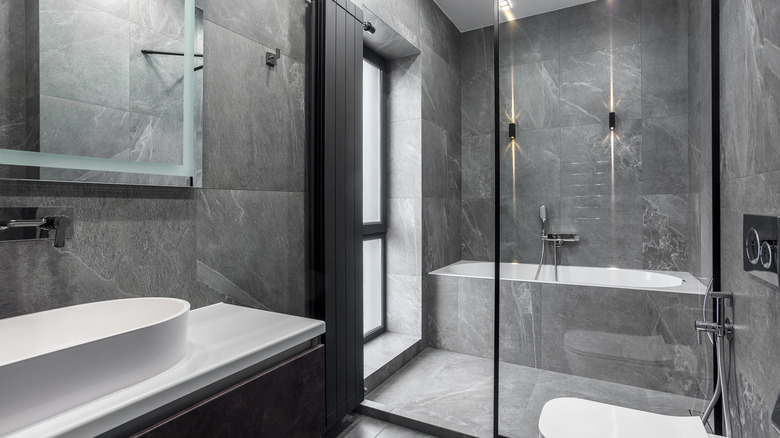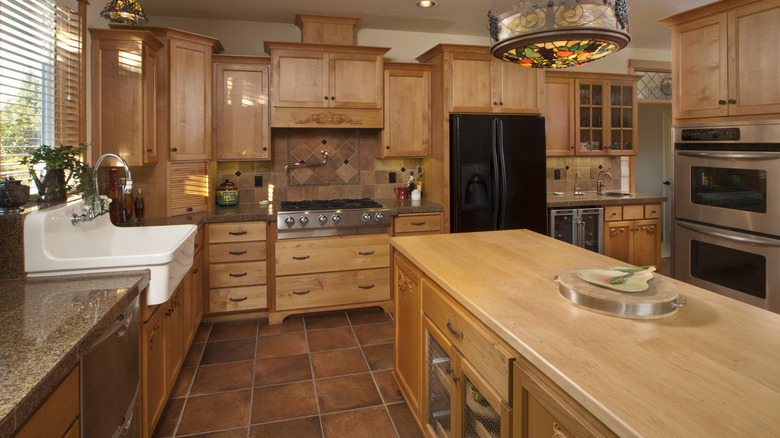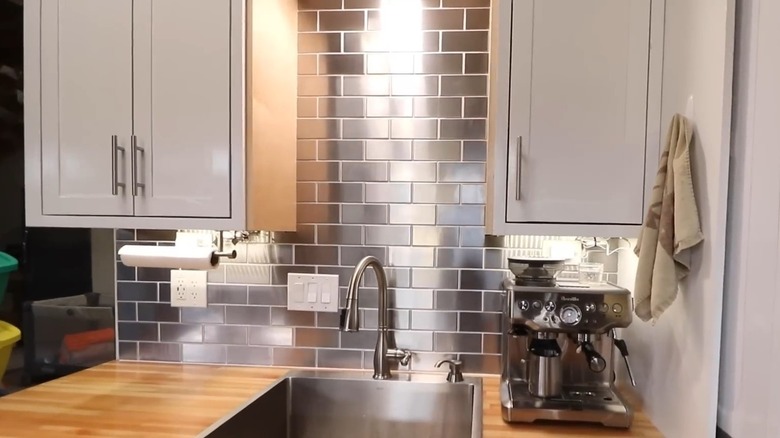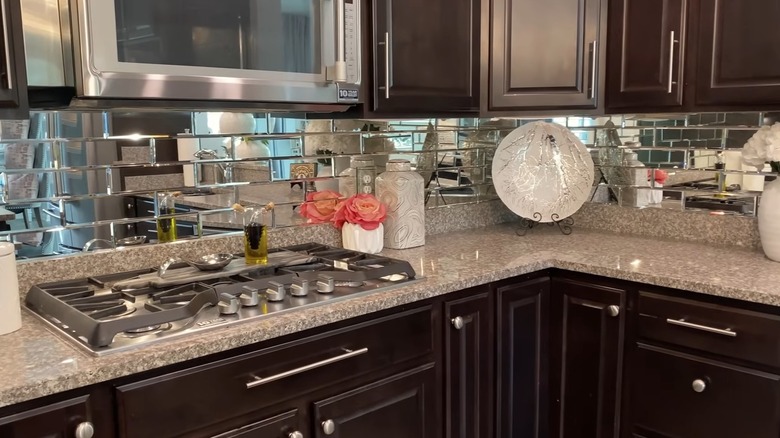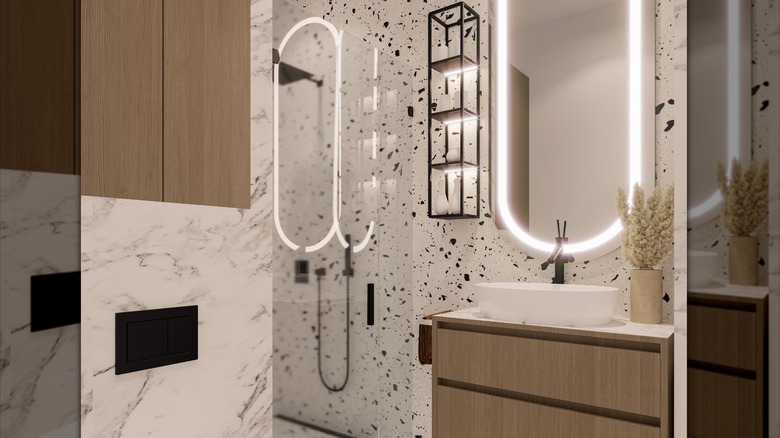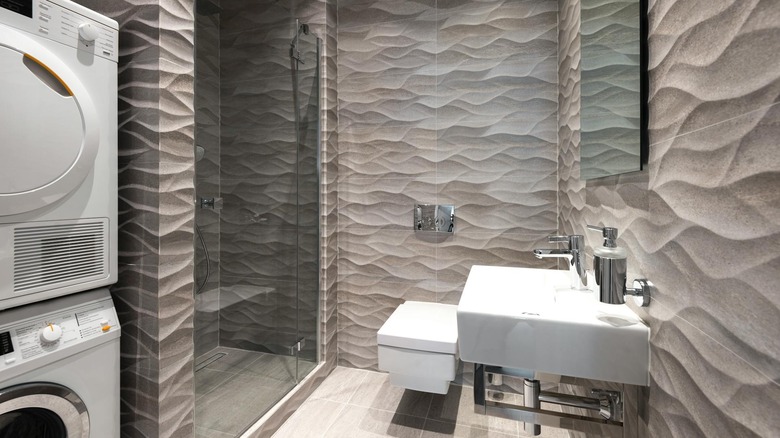21 Types Of Tiles To Use In Your Kitchen And Bathroom
Choosing the right tile for kitchens and bathrooms requires balancing aesthetics with high-performance functionality. These rooms face demanding environmental factors, from high foot traffic and daily wear to constant exposure to moisture and heat. Therefore, for many, longevity is key to decision-making in design. On a practical level, the best tiles for floors, walls, and backsplashes must be waterproof, durable, easy to clean, and stain-resistant.
While practical choices like porcelain and ceramic tiles (yes, there's a difference between them!) offer durable, cost-effective, and low-maintenance solutions, they don't require you to sacrifice style. Both materials are available in endless shapes, colors, and patterns, making them as fashionable as they are wear-resistant. On the flip side, materials like marble offer unrivaled and highly aesthetic luxury. Though it is a high-density stone that holds up well, marble and like-natured stones demand more careful maintenance. However, how a space looks and feels may be worth it to some homeowners for its maintenance and price tag. Ultimately, the decision rests on your priorities: whether you value the effortless practicality of durable materials or are willing to accept extra care for a specific, high-end aesthetic. The goal is to find a tile that is both beautifully imagined and perfectly suited to the demands of your space, and trust us, there are many different tile types to choose from!
Ceramic tile
Ceramic tile is both a timeless and practical choice for your bathroom and kitchen. Composed of clay, fired at a high temperature, and then finished with a glaze, ceramic offers great longevity if you're looking for a material that requires little to no maintenance, yet boasts uncompromising durability. It's easy to clean and resistant to water stains, but also much cheaper than similar counterparts like porcelain. Available in a range of colors and patterns, it's budget-friendly for the economically-minded homeowner without having to compromise on ideal design aesthetics in your space.
Porcelain tile
Porcelain tile is actually a type of ceramic tile, distinguishable by its manufacturing process, which results in a denser, stronger, and less porous product. It is made from a highly refined, fine clay and other materials that, when fired at extremely high temperatures (over 2,000 degrees Fahrenheit!), create an incredibly durable and water-resistant tile that's low maintenance, stain-resistant, and bacteria-resistant. It's a wonderfully diverse material that can come in a broad range of patterns, colors, shapes, and sizes, often mimicking the look of natural stones like marble, if that's important to your design taste.
Travertine tile
Travertine tile is a durable natural material that has a superpower — it can withstand high temperatures as well as temperature fluctuations, making it a great option for bathrooms where you may use lots of hot water and experience steam, or in kitchens where hot ingredients may splash on the ground or on backsplashes. Aesthetically, it warms up a classic neutral palette and works well with a number of different decor pieces and accents. Ranging from about $5 per square foot up to $20 per square foot, it's best to seal the travertine before use to prevent damage.
Limestone tile
A similar aesthetic to travertine, limestone is another earthy tile material that exudes organic warmth. It brings a timeless, effortless, and elegant touch to bathrooms and kitchens, given its soft, neutral tones and natural patterns. It's another porous, natural stone, however, so be sure to seal your limestone tiles regularly and use pH-neutral cleaners so that the surface doesn't stain or get marked. Though cheaper than marble, it can be just as maintenance-heavy, so keep the cleaning routines in mind if you're looking at limestone, and make sure it fits with your lifestyle.
Cement tiles
Giving more of a modern, industrialist chic look, consider a cement tile in the bathroom or kitchen. Like with natural stones, cement does need to be sealed upon installation due to its porosity (even though it is a manufactured material). It will require regular maintenance to prevent water staining, particularly in high-moisture environments like bathrooms, but the payoff is an incredibly sleek look. Cement is highly durable and can withstand pressure though — colored patterns are also known to stay intact — so using it for floors in kitchens and bathrooms makes for a great, long-lasting design.
Glass tile
A more unique choice for bathrooms and kitchens, glass tiles are great on walls and backsplashes specifically due to their non-porous nature. This makes the material resistant to pesky bathroom issues like bacteria, mold, and mildew, and glass is also stain-resistant and water-damage resistant. If you're a cleaning enthusiast who loves a squeaky clean, hygienic space, then glass is an optimal tile choice. Aesthetically speaking, glass tiles also reflect light, creating a bright atmosphere in spaces and making rooms appear larger than they actually are in many cases. It's no wonder colorful glass backsplashes are trending in design!
Marble tile
Marble is the holy grail of luxe tiles, and it sure does pack a big design punch in bathrooms and kitchens. On one hand, marble tends to increase home value to reflect the luxury material, and the marble itself is reflective and naturally cool for those who love sensory touches. However, marble also requires regular maintenance, not unlike other natural stones or cement. The cost of installation of marble is also generally higher than other tile choices. However, if the enduring cool factor of a marble kitchen or bathroom is important to you, then nothing beats that look.
Mosiac tile
Not so much a material as a style, mosaic offers a fresh, modern take on some of your favorite tile materials. The smaller tiles allow designers and homeowners to play with patterns and colors, which opens up the ability to create incredibly unique spaces on kitchen backsplashes or bathroom walls. It can transform an ordinary, utilitarian space into an interesting design focal point. On a practical level, the large number of grout lines in mosaics provides slip resistance when used in bathrooms. They are also ideal for covering irregular surfaces, providing a cleaner finish than larger tiles.
Quartzite tile
Quartzite is a naturally beautiful, yet durable material for tiles in kitchens and bathrooms. Its marble-like appearance gives it an air of traditional elegance, while functionally, it is highly resistant to scratches and abrasions. This material is also less porous than other natural stones, which means it's not as susceptible to damage when acidic materials, like lemon juice, come into contact. Quartzite can be more expensive than marble to purchase, fluctuating from $65 to $190 per square foot, but it can be much less work to maintain, making it a kitchen countertop trend you'll see everywhere in 2026.
Slate tile
A distinct natural stone known for its hallmark color and depth, slate tile is another durable stone. It does require sealing periodically to handle moist environments like its other porous counterparts, but it's resistant to scratches and chipping, and is even considered naturally slip-resistant due to its textured surface. In the long run, it's a great investment for its longevity and practicality in use and wear; however, installing this stone is a complex process, so the initial investment may feel pricey. Cleaning and caring for slate floors may be more intensive than low-maintenance choices as well.
Terracotta tiles
An eco-friendly option on this list, terracotta tiles are a naturally baked material that's non-toxic, recyclable, and durable. Terracotta also improves energy efficiency within your home as it can absorb heat and slowly release it, helping naturally regulate temperatures during seasons with extreme weather. For kitchens and bathroom spaces, it's worth noting that terracotta is highly porous and will require regular resealing to resist water damage or staining, similar to cement. Maintenance, therefore, can become an issue for those who want to have low-intervention spaces that they don't have to worry about as often.
Anthracite tile
Anthracite describes the tile's finish and color, rather than material, which is often porcelain or ceramic. But that's the best part — it looks like cement or slate but with the moisture-resistant benefits of manufactured materials. In terms of maintenance, it one-ups its dark gray, natural stone cousins. With a textured or matte finish, anthracite tiles offer good slip resistance, making them a modern, bold, and chic choice with practicality in mind. A reasonably priced material that can be found for under $10 a square foot (sometimes even under $5), it offers fashionable aesthetics for lower price points.
Pebble tile
Reminiscent of your favorite spa, pebble tiles are known for their organic texture, which also incidentally makes them naturally slip-resistant for wet areas in bathrooms or kitchens. Particularly well-suited for shower floors, walls, and kitchen backsplashes, pebble tile is durable as well as versatile. It holds up well to moisture and high traffic, and on floors specifically, it has a fantastic underfoot feel — it's like a massage every time you walk on it. Typical costs are between $6 and $30 per square foot, with prices varying based on the stone type and finish (sliced or tumbled).
Granite tile
A classic choice for kitchen and bathroom spaces, granite tiles have a reputation for being outstandingly durable in high-use areas. The material itself is low-porous, heat-resistant, stain-proof, and scratch-resistant, making it a fan favorite on floors, walls, countertops, and backsplashes. Because of its density and non-porous characteristics, it's also relatively mildew or mold-proof, and even though granite does require sealing like other natural stones, its density makes it more low-maintenance than alternatives that require both sealing and monitoring in damp environments. It can read more traditional, though, so keep that in mind during design.
Serpentine tiles
For fans of "The Wizard of Oz" or "Wicked", you can live out your Emerald City dreams with serpentine tile in your bathrooms or kitchens. A jade-like natural stone that's generally low-porous, it's an unexpected pop of color that's still elegant for floors, vanities, backsplashes, and walls. Durability-wise, it is softer than granite and can be affected by acidic substances or pressure, so bear in mind that careful sealing and consistent maintenance will be necessary to protect these tiles in high-traffic spaces. However, if you're willing to commit to taking care of serpentine, it's a stunning green marble-esque choice.
Soapstone tile
Soapstone is a popular, yet pricey material for kitchen countertops, but for good reason — it's elegant, understated, and versatile. In tiles for bathrooms and kitchens, however, its use is a bit more nuanced. Highly heat-resistant, soapstone tile is great for backsplashes and shower walls where extreme temperature swings can occur, but it's also much softer than granite or marble so it can be prone to scratches or chips if used in high-traffic areas. Thus, you may want to avoid using soapstone tiles for floors, particularly if you have children and pets that are hard on surfaces.
Quarry tiles
Tiles with a bit of a retro flair, quarry tiles are unglazed, naturally slip- and stain-resistant materials often used in both indoor and outdoor spaces. Composed of thick, hard clays fired at extremely high temperatures, quarry tiles have low porosity and can handle high amounts of moisture. Clay is still porous, however, so like terracotta, quarry tiles will require sealing. These tiles may also absorb oils over time, which can affect their look. At the end of the day, though, quarry tiles are extremely long-lasting, working well in spaces with consistent foot traffic.
Metal tiles
A tile choice that feels both historic and modern, metal tiles were en vogue in the 19th and early 20th centuries for their statement appearance and as a substitute for more complex plaster work. Today, metal tiles are gaining traction as trendy, modern design accents that brighten spaces with their reflective nature and lend a sleek sophistication to an otherwise utilitarian room. Practicality-wise, metal surfaces are bacteria-resistant and highly sanitary, impervious to moisture, mold, or mildew. As you can imagine, metal is also very durable, outperforming ceramic and porcelain options, too.
Mirror tiles
Similar to glass and metal, mirror tiles are durable, incredibly sanitary materials that can be used in kitchens and bathrooms, which experience a lot of heat fluctuation and moisture. As another reflective material choice, it offers similar visual benefits as metallic tiles, like making a smaller space feel larger and brighter than it actually is. For a slightly more elegant historic air, choose a mirror tile with antiqued patina or with a bevel edge for an eye-catching design accent. Or for something more contemporary, opt for modern mosaic shapes or subway patterns.
Terrazzo tile
A composite material, made of marble, quartz, or glass chips set into a binder, terrazzo is a nearly indestructible tile material. Its key benefit in wet and high-traffic areas like kitchens and bathrooms is its non-porous nature when well sealed, making it resistant to stains, moisture, and bacteria. Because you can customize the chip colors and sizes, it's a versatile tile material that can speak to any design language you'd like it to. The cost of pre-cast terrazzo tiles can be variable, so research materials for a final price and ensure you're getting real terrazzo and not a simulant.
Three-dimensional tile
Another style recommendation that spans materials, think outside the box with a three-dimensional touch to your bathrooms and kitchens. Just because these are high-use rooms in the house doesn't mean they need to be overly utilitarian or boring, and three-dimensional tiles allow you to pick a material that works well with your lifestyle while also adding unique touches that don't look so cookie-cutter. For textured 3D tiles, you're likely looking at porcelain, glass, ceramic, or PVC, but if you don't want to clean over bumps and waves, opt for an optical 3D tile instead.
